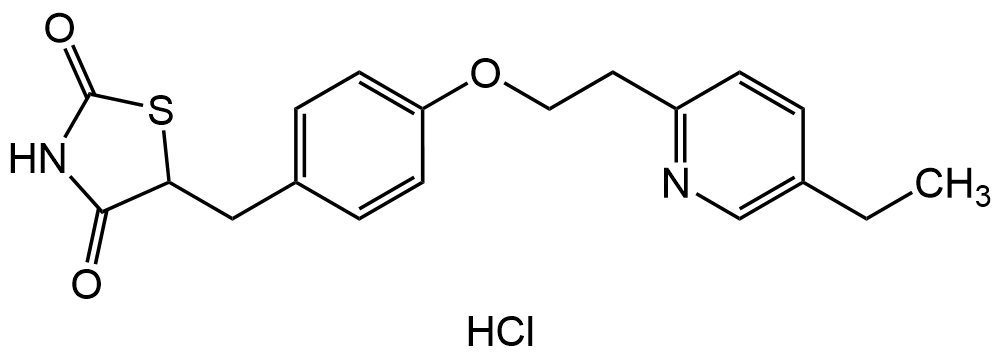Pioglitazone hydrochloride
Product Code:
CDX-P0733
CDX-P0733
Regulatory Status:
RUO
RUO
Shipping:
Ambient
Ambient
Storage:
Short term: +20°C. Long term: +20°C
Short term: +20°C. Long term: +20°C
No additional charges, what you see is what you pay! *
| Code | Size | Price |
|---|
| CDX-P0733-M010 | 10 mg | £64.00 |
Quantity:
| CDX-P0733-M050 | 50 mg | £220.00 |
Quantity:
Prices exclude any Taxes / VAT
Stay in control of your spending. These prices have no additional charges to UK mainland customers, not even shipping!
* Rare exceptions are clearly labelled (only 0.14% of items!).
* Rare exceptions are clearly labelled (only 0.14% of items!).
Multibuy discounts available! Contact us to find what you can save.
This product comes from: Switzerland.
Typical lead time: 7-10 working days.
Contact us for more accurate information.
Typical lead time: 7-10 working days.
Contact us for more accurate information.
- Further Information
- Documents
- References
- Show All
Further Information
Appearance:
White to off-white powder.
CAS:
112529-15-4
Description:
Pioglitazone hydrochloride is a proliferator-activated receptor gamma (PPARgamma) agonist (EC50 = ~500-600nM for both human and murine PPARgamma) and thiazolidinedione (TZD) anti-diabetic. Pioglitazone is a selective agonist of the nuclear receptor peroxisome proliferator-activated receptor gamma (PPAR-gamma) and to a lesser extent PPAR-alpha. Pioglitazone hydrochloride is usually used to treat type-II diabetes in vivo and has the ability to block hepatic gluconeogenesis. Pioglitazone inhibits pyruvate oxidation and glucose production in hepatocytes when used at a concentration of 10 uM. In vivo, pioglitazone (0.3-3mg/kg per day) reduces hyperglycemia, hyperlipidemia, and hyperinsulinemia in a dose-dependent manner in male Wistar fatty rats. It shos also anti-inflammatory and anti-arteriosclerosis effects.
EClass:
32160000
Form:
solid
GHS:
GHS07, GHS08
Handling Advice:
Protect from light and moisture.
Hazards:
H302,H351
InChi:
InChI=1S/C19H20N2O3S.ClH/c1-2-13-3-6-15(20-12-13)9-10-24-16-7-4-14(5-8-16)11-17-18(22)21-19(23)25-17;/h3-8,12,17H,2,9-11H2,1H3,(H,21,22,23);1H
InChi Key:
GHUUBYQTCDQWRA-UHFFFAOYSA-N
MDL:
MFCD04975446
Molecular Formula:
C19H20N2O3S . HCl
Molecular Weight:
392.9
Package Type:
Vial
Precautions:
P202-P264-P280-P301 + P312-P308 + P313-P405
Purity:
>98% (HPLC)
Signal word:
Warning
SMILES:
CCC(C=C1)=CN=C1CCOC2=CC=C(CC3SC(NC3=O)=O)C=C2.Cl
Solubility:
Soluble in DMSO or DMF (both 10mg/ml).
Source / Host:
Synthetic
Transportation:
Non-hazardous
UNSPSC Number:
12352200
Use & Stability:
Stable for at least 2 years after receipt when stored at RT.
Documents
References
(1) Y. Sugiyama, et al.; Arzneimittelforschung 40, 263 (1990) | (2) J.M. Lehmann, et al.; J. Biol. Chem. 270, 12953 (1995) | (3) T.M. Willson, et al.; J. Med. Chem. 39, 665 (1996) | (4) J. Sakamoto, et al.; BBRC 278, 704 (2000) | (5) T.M. Willson, et al.; J. Med. Chem. 43, 527 (2000) | (6) M. Ishibashi, et al.; Hypertension 40, 687 (2002) | (7) P. de Pablos-Velasco; Expert Rev. Cardiovasc. Ther. 8, 1057 (2010) | (8) C. Ao, et al.; Cell Biol. Int. 34, 723 (2010) | (9) H.L. Zhang, et al.; Neuroscience 176, 381 (2011) | (10) Q. Zhao, et al.; J. Neuroinflamm. 13, 259 (2016) | (11) S. Suzuki, et al.; Int. J. Mol. Sci. 17, E2071 (2016) | (12) C.E. Shannon, et al.; FEBS J. 284, 451 (2017)



